Related Research Articles

The nucleolus is the largest structure in the nucleus of eukaryotic cells. It is best known as the site of ribosome biogenesis, which is the synthesis of ribosomes. The nucleolus also participates in the formation of signal recognition particles and plays a role in the cell's response to stress. Nucleoli are made of proteins, DNA and RNA, and form around specific chromosomal regions called nucleolar organizing regions. Malfunction of nucleoli can be the cause of several human conditions called "nucleolopathies" and the nucleolus is being investigated as a target for cancer chemotherapy.

The African clawed frog, also known as simply Xenopus, African clawed toad, African claw-toed frog or the Platanna) is a species of African aquatic frog of the family Pipidae. Its name is derived from the short black claws on its feet. The word Xenopus means 'strange foot' and laevis means 'smooth'.

Fertilisation or fertilization, also known as generative fertilisation, syngamy and impregnation, is the fusion of gametes to give rise to a new individual organism or offspring and initiate its development. While processes such as insemination or pollination which happen before the fusion of gametes are also sometimes informally referred to as fertilisation, these are technically separate processes. The cycle of fertilisation and development of new individuals is called sexual reproduction. During double fertilisation in angiosperms the haploid male gamete combines with two haploid polar nuclei to form a triploid primary endosperm nucleus by the process of vegetative fertilisation.

Xenopus is a genus of highly aquatic frogs native to sub-Saharan Africa. Twenty species are currently described within it. The two best-known species of this genus are Xenopus laevis and Xenopus tropicalis, which are commonly studied as model organisms for developmental biology, cell biology, toxicology, neuroscience and for modelling human disease and birth defects.

The blastocoel, also spelled blastocoele and blastocele, and also called cleavage cavity, or segmentation cavity is a fluid-filled or yolk-filled cavity that forms in the blastula during very early embryonic development. At this stage in mammals the blastula develops into the blastocyst containing an inner cell mass, and outer trophectoderm.

The zona pellucida is a specialized extracellular matrix that surrounds the plasma membrane of mammalian oocytes. It is a vital constitutive part of the oocyte. The zona pellucida first appears in unilaminar primary oocytes. It is secreted by both the oocyte and the ovarian follicles. The zona pellucida is surrounded by the corona radiata. The corona is composed of cells that care for the egg when it is emitted from the ovary.
In biology, polyspermy describes the fertilization of an egg by more than one sperm. Diploid organisms normally contain two copies of each chromosome, one from each parent. The cell resulting from polyspermy, on the other hand, contains three or more copies of each chromosome—one from the egg and one each from multiple sperm. Usually, the result is an unviable zygote. This may occur because sperm are too efficient at reaching and fertilizing eggs due to the selective pressures of sperm competition. Such a situation is often deleterious to the female: in other words, the male–male competition among sperm spills over to create sexual conflict.

Pestivirus is a genus of viruses, in the family Flaviviridae. Viruses in the genus Pestivirus infect mammals, including members of the family Bovidae and the family Suidae. There are 11 species in this genus. Diseases associated with this genus include: hemorrhagic syndromes, abortion, and fatal mucosal disease.

Furin is a protease, a proteolytic enzyme that in humans and other animals is encoded by the FURIN gene. Some proteins are inactive when they are first synthesized, and must have sections removed in order to become active. Furin cleaves these sections and activates the proteins. It was named furin because it was in the upstream region of an oncogene known as FES. The gene was known as FUR and therefore the protein was named furin. Furin is also known as PACE. A member of family S8, furin is a subtilisin-like peptidase.
The vitelline membrane or vitelline envelope is a structure surrounding the outer surface of the plasma membrane of an ovum or, in some animals, the extracellular yolk and the oolemma. It is composed mostly of protein fibers, with protein receptors needed for sperm binding which, in turn, are bound to sperm plasma membrane receptors. The species-specificity between these receptors contributes to prevention of breeding between different species. It is called zona pellucida in mammals. Between the vitelline membrane and zona pellucida is a fluid-filled perivitelline space.

Zona pellucida sperm-binding protein 2 is a protein that in humans is encoded by the ZP2 gene.

Disintegrin and metalloproteinase domain-containing protein 2 or Beta-fertilin is an enzyme that in humans is encoded by the ADAM2 gene.
Vitellin is a protein found in the egg yolk. It is a phosphoprotein. Vitellin is a generic name for major of many yolk proteins.
CUB domain is an evolutionarily conserved protein domain. The CUB domain is a structural motif of approximately 110 residues found almost exclusively in extracellular and plasma membrane-associated proteins, many of which are developmentally regulated. These proteins are involved in a diverse range of functions, including complement activation, developmental patterning, tissue repair, axon guidance and angiogenesis, cell signalling, fertilisation, haemostasis, inflammation, neurotransmission, receptor-mediated endocytosis, and tumour suppression. Many CUB-containing proteins are peptidases belonging to MEROPS peptidase families M12A (astacin) and S1A (chymotrypsin).
Egg jelly is a gelatinous layer that surrounds the oocytes of many organisms and releases species-specific chemoattractants that activate and guide sperm to the oocyte. The release of chemoattractants is species dependent. For example, sperm in Lytechinus variegatus, the green sea urchin, are not chemotactically attracted to the jelly or the egg. The egg jelly is located immediately surrounding the vitelline envelope and consists primarily of a network of short peptides and sulfated fucan glycoproteins. These short peptides diffuse into the surrounding area and stimulate respiration and movement of the sperm to the egg. An example of such a peptide is resact, which has been studied as the primary means of attracting and orientating sperm to the eggs in sea urchins. The sulfated fucan glycoproteins play an important role in binding to sperm receptors and triggering the acrosomal reaction.

Intelectins are lectins expressed in humans and other chordates. Humans express two types of intelectins encoded by ITLN1 and ITLN2 genes respectively. Several intelectins bind microbe-specific carbohydrate residues. Therefore, intelectins have been proposed to function as immune lectins. Even though intelectins contain fibrinogen-like domain found in the ficolins family of immune lectins, there is significant structural divergence. Thus, intelectins may not function through the same lectin-complement pathway. Most intelectins are still poorly characterized and they may have diverse biological roles. Human intelectin-1 (hIntL-1) has also been shown to bind lactoferrin, but the functional consequence has yet to be elucidated. Additionally, hIntL-1 is a major component of asthmatic mucus and may be involved in insulin physiology as well.
Darcy Brisbane Kelley, is an American neurobiologist and currently a Weintraub and HHMI Professor in the Department of Biological Sciences at Columbia University. She is also Co-Director of Columbia’s Graduate Program in Neurobiology and Behavior and Editor of Developmental Neurobiology, and well known for her contributions to neuroethology, particularly the neural control of vocalization in Xenopus and the cellular and molecular mechanisms of sexually differentiated acoustic communication.

Hazel L. Sive is a South African-born biologist and educator. She is Dean of the College of Science, and Professor of Biology at Northeastern University. Sive is a research pioneer, award-winning educator and innovator in the higher education space who was elected as a Fellow of the American Association for the Advancement of Science in November 2021. Prior to June 2020, she was a Member of Whitehead Institute for Biomedical Research, Professor of Biology at Massachusetts Institute of Technology and Associate Member of the Broad Institute of MIT and Harvard. Sive studies development of the vertebrate embryo, and has made unique contributions to understanding how the face forms and how the brain develops its structure. Her lab also seeks to understand the origins of neurological and neurodevelopmental disorders, such as epilepsy, autism, Pitt–Hopkins syndrome and 16p11.2 deletion syndrome.

Rebecca W. Heald is an American professor of cell and developmental biology. She is currently a Professor in the Department of Molecular & Cell Biology at the University of California, Berkeley. In May 2019, she was elected to the National Academy of Sciences. She has published over 90 research articles in peer reviewed journals.
Xenopus egg extract is a lysate that is prepared by crushing the eggs of the African clawed frog Xenopus laevis. It offers a powerful cell-free system for studying various cell biological processes, including cell cycle progression, nuclear transport, DNA replication and chromosome segregation. It is also called Xenopus egg cell-free system or Xenopus egg cell-free extract.
References
- ↑ Hardy DM, Hedrick JL (May 1992). "Oviductin. Purification and properties of the oviductal protease that processes the molecular weight 43,000 glycoprotein of the Xenopus laevis egg envelope". Biochemistry. 31 (18): 4466–72. doi:10.1021/bi00133a012. PMID 1581303.
- ↑ Lindsay LL, Wieduwilt MJ, Hedrick JL (April 1999). "Oviductin, the Xenopus laevis oviductal protease that processes egg envelope glycoprotein gp43, increases sperm binding to envelopes, and is translated as part of an unusual mosaic protein composed of two protease and several CUB domains". Biology of Reproduction. 60 (4): 989–95. doi: 10.1095/biolreprod60.4.989 . PMID 10084976.
- ↑ Hiyoshi M, Takamune K, Mita K, Kubo H, Sugimoto Y, Katagiri C (March 2002). "Oviductin, the oviductal protease that mediates gamete interaction by affecting the vitelline coat in Bufo japonicus: its molecular cloning and analyses of expression and posttranslational activation". Developmental Biology. 243 (1): 176–84. doi: 10.1006/dbio.2001.0558 . PMID 11846486.
- ↑ Hiyoshi, Masateru; Takamune, Kazufumi; Mita, Koichi; Kubo, Hideo; Sugimoto, Yasusi; Katagiri, Chiaki (March 2002). "Oviductin, the Oviductal Protease That Mediates Gamete Interaction by Affecting the Vitelline Coat in Bufo japonicus: Its Molecular Cloning and Analyses of Expression and Posttranslational Activation". Developmental Biology. 243 (1): 176–184. doi: 10.1006/dbio.2001.0558 . PMID 11846486.